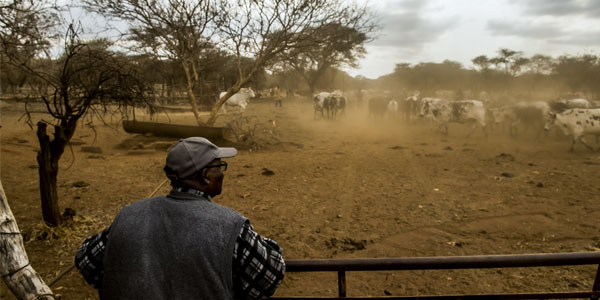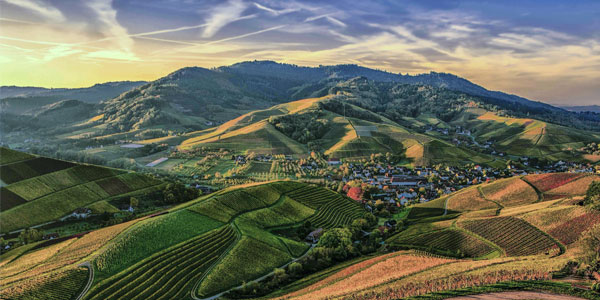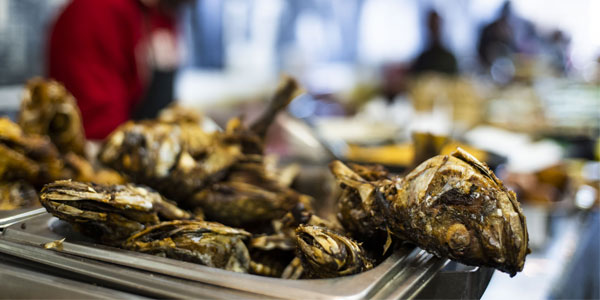
Food takes root in Africa
- Ufrieda Ho
Africa has the ability and resources to feed the world, but much needs to be done on a continent full of challenges, opportunities and pitfalls.
Heard of the lablab bean? No? It is not surprising, but this indigenous African pulse is a metaphor for the continent’s potential to beat food insecurity – provided we’re wiser about optimising what we have.
The lowly Lablab purpureus, also known as the Hyacinth bean, is widely consumed in the tropical and sub-tropical regions of Africa. It is a hardy plant that grows wild in nature, gets the thumbs-up for taste, is high in protein and is versatile enough to be served for dinner or to be used in animal feed.

Bean potential
Professor Mulala Simatele in the School of Geography, Archaeology and Environmental Studies at Wits is a fan, even though the beans are not big on menus and don’t make it into supermarket veggie aisles.
For Simatele, the lablab bean represents an opportunity for the continent to think about biodiversity in a time of climate change, widening urban-rural divides, continued technological deficiencies, a low skills base and yawning wealth gaps.
“We have to go back to basics, think about how to optimise scarce resources like water and start realising that Africa’s food security crisis cannot be addressed just by looking at it through a single lens,” says Simatele.
One of the basics Simatele names is switching to growing a wider range of indigenous crops. These crops will better withstand the coming extreme weather patterns. Another of Simatele’s basics is promoting food production in urban and peri-urban areas, closer to where most people live, in order to reduce energy and fuel needs that add up to larger carbon footprints. There’s also room to strengthen networks across disciplines – from weather monitoring through engineering to indigenous knowledge systems, and even activism to shift policy and hold leaders to account.
The lay of the land
Simatele says the food crisis for the continent is complex and is a mirror of multiple failings and pressures in society. It has taken hold over generations, compounded by everything from a legacy of highly industrialised agricultural practices that have excluded those with limited financial access, to the dominance of crops imported to the continent in a colonial era, to present-day bad governance and corruption.
But somewhere between the picture of Africa as a write-off and Africa as the new food Eden, is a version of the continent that is less exaggerated and in its honesty holds plainer answers to what strategy, resilience-building and appropriate adaptability for food security must look like.
The dirt on soil
For Professor Mary Scholes who holds a Research Chair in Systems Analysis in the School of Animal, Plant and Environmental Sciences at Wits, a crucial starting point is identifying what we have so that we know how to harness its potential. As a soil expert, Scholes says that because Africa has mostly old, tropical weather soils, we have a limited amount of fertile, arable soil.
Imperatives that may help the soil are the correct use of fertilisers and better adjudication in granting water-use licences, especially in areas where water is the most limiting resource.
“Inorganic fertiliser used correctly can boost the soil’s phosphorus and nitrogen composition to improve yields in the short-term,” says Scholes. “Organic fertilisers like maize stover, grass clippings and chicken or cattle manure may be more sustainable in the long-term, but you may need huge amounts for it to be effective, which is not always practical.”
On water licences, Scholes gives the example of how, in some instances, it makes more sense to give licences for ventures in aquaponics rather than for maize crops. Humans require a balanced diet of proteins, carbohydrates and minerals and these needs should be met by regional production to minimise transport costs.

The green revolution and genetically modified crops
Africa “missed” the agricultural revolution of the 1960s. The so-called “green revolution” of that time had its pitfalls, including soil erosion, mono cropping and increasing the pesticide load in the environment. On the flipside, the form of farming that embraced science and technological approaches – including the use of hybridised seeds, pesticides and improved irrigation systems – made large-scale farming possible in more areas and for longer periods throughout the year. Judicious funding was also integral to the success of the green revolution. It is widely regarded as an intervention that solved starvation among the most vulnerable people in the world half a century ago.
This is why Scholes doesn’t discount the role of genetically modified (GM) crops. GM foods and crops continue to divide the room and remain controversial. Critics shun it over concerns about its impact on the environment and for the long-term health of people and animals. It is also considered problematic in deepening the commoditisation of food, entrenching corporate monopolies and muscling out smaller farmers.
Scholes says though, “If you are wealthy, you have the choice to walk into a supermarket and choose a product that is GMO-free, but if you are poor, it is a case of eat GMOs or starve.”
Pragmatism and sensible, informed decision-making matters in overcoming food insecurity, says Scholes.
For Dr Tracy Ledger, a researcher at the Public Affairs Research Institute (PARI), sensible decision-making stops when food is not affordable and accessible to most of the population. Ledger wrote the book, An empty plate: Why we are losing the battle for our food system, why it matters and how we can win it back. She believes we produce enough food – but we’re not making it accessible to those who need it most.
“We live with a system of buyer-led (retailer) value chains,” says Ledger. “Just because you grow more food does not mean you are better off. If you grow more maize in the Eastern Cape, it does not mean you are going to put food on the table for a family in Ivory Park. The planet already produces enough food. The problem is people don’t have access to it.”
According to Ledger, it is crucial to understand the enormous implications that the skewed food system has on our society.
Land and food
This skewed food system includes the way we grow, buy and distribute food. It includes the costs associated with getting a plate of food on the table, issues of land tenure, title deeds, microfinancing, and access to markets, science, and technology for many smallholder farmers.
“It is a wicked problem for smallholder farmers stuck in debt and still not growing enough in some years. You also can’t expect people to care for the land and to grow food on the land if they do not have title deeds or secure tenure,” says Scholes.
Land reform and land expropriation have dragged on in South Africa. Settling the matter decisively and smartly can bring about the clarity and stability needed to shape policies around food security.
This is part of the good governance and leadership that needs to be threaded through everything, including food security strategies, says Professor Ronald Wall, who holds the Chair in Economic Development of the City of Johannesburg in the School of Economic and Business Sciences at Wits.
Sound governance, cooperation and vision are at the heart of Wall’s best-case scenario for a transformed continent that can attract the right kind of foreign direct investments (FDI).
FDI improves everything from medium to high-tech infrastructure development through to better sanitation – all of which impact on improving agriculture and food processing, which in turn can help make Africa more food secure and more prosperous.
Good governance for (food) growth
Wall, a chief researcher and author of the UN-Habitat report The State of the African Cities 2018 report: The geography of African investment released in July 2018, believes there are reasons to be optimistic. Positives are Africa’s large youth population, the opportunity to optimise low, medium and high-tech production in the pockets of arable land (particularly in cities and peri-urban areas) and the opportunity to leapfrog errors made by other countries and to experiment with new ideas and technologies.
“Agriculture and investment in agriculture have been under-looked for a long time because farming is considered to be linked to poverty and to things low-tech and rural. But we have an opportunity to combine knowledge-intensive food production and our huge human resource in young people to create employment and opportunity through valued-added agricultural processing businesses,” says Wall.

City farms
South Africa’s nascent city food gardens, A-frame hydroponic rooftop gardens, food gardening as landscape, and food waste management initiatives represent a trend of agro-urbanity and creative problem solving. It attracts young people who see themselves as farmers and agricultural entrepreneurs.
“We need to be able to build cities that are a mosaic of productive areas. Road networks and infrastructure need to improve to close the urban-rural divide. This helps cool the unprecedented rate of African urbanisation, while giving opportunity to people in rural areas. Food production should be something that is part of city life, not something that happens somewhere faraway.”
Wall believes urban people need to experience food systems to see explicitly that they are also about political power and investment flows. He warns, for example, that Africa’s arable land is being gobbled up by food multinationals to grow food for export markets, not the continent’s people.
“Africa is a potential food basket for the world, but not for Africans themselves,” says Wall.
Ledger says a great example of this is the state of the small dairy farming industry, which has been decimated in South Africa. In recent years, 5 000 small dairy farmers who used to provide 50 000 jobs in the country have gone out of business.
“Farmers get paid R4.80 per litre of milk that is sold for over R15 in the shop, so almost every small dairy farmer in South Africa has gone out of business. Farmers take all the risk with producing milk, while retailers (and to a lesser extent, processors) make most of the profit,” says Ledger.
Wall and his fellow authors write in the UN-Habitat report of the dangerous seduction of food FDI in Africa that is only concentrated on land acquisition and international food exports. Bad deals with multinationals negatively affect local economies due to related social, economic and political conflict. Fairer deals should include the likes of joint ventures, increased local employment and guaranteed technology transfer to local producers.
“Studies have shown that 115 million acres of agricultural land have been leased to investors worldwide (international land outsourcing for food exports) and that the bulk of this is in Africa (Land Matrix, 2016). Hence, food investment in Africa has become a ‘resource-seeking production and export platform’ venture that generally does not support local food availability.”
Wall, like Simatele, says protection and pushback against international pressure comes down to engaged, critically aware citizenry and good governance. Regional economic communities like the Southern African Development Community or the Economic Community of West African States need to be strong and the African Union as a whole has to be able to withstand potential exploitation through skewed deals.
“You can’t have a case where a foreign firm negotiates with one country and if it doesn’t get the deal it wants simply goes to a neighbouring country to make a similarly bad deal,” says Wall.
He has more bad news, pointing out that land grabbing, inefficient land administration, poor documentation, lack of transparency, low capacity and the demand for land surveyors are all barriers to attracting the FDI that could positively impact food security.
Still, Wall is optimistic and says vision and hope have very real roles to play in turning things around for the continent. These may seem intangible, but inspiration, imagination and optimism are the stuff that make people believe they can and should map out their future solutions, rather than remaining stuck in dead ends.
Hope may seem a huge leap for the question of how dinner gets on to a plate tonight, but planting and nurturing a seed gives it every chance to grow to its fullest potential.
Read the State of African Cities 2018 report.
- Ufrieda Ho is a freelance journalist.
- This article first appeared in Curiosity, a research magazine produced by Wits Communications and the Research Office.
- Read more in the sixth issue, themed: #HungerGames where our researchers and academics unpack the latest research on food security, food science, food politics and governance, nutrition and food-related issues such as obesity, diets, breastfeeding, and body image.

